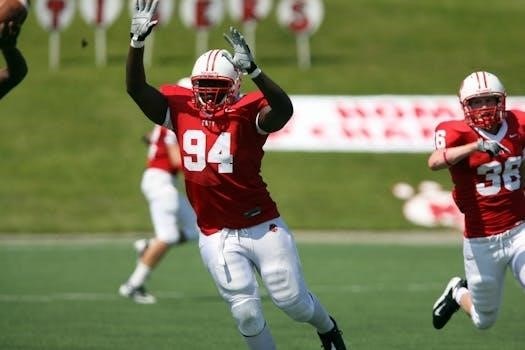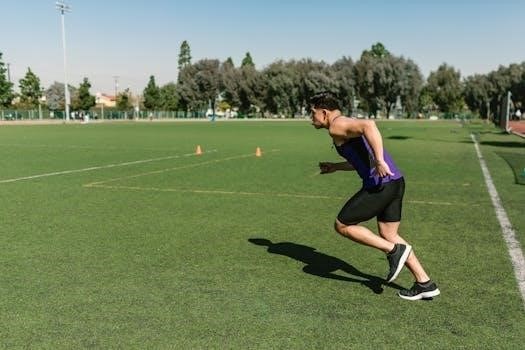
Welcome to the world of 100m sprint training! This guide dives into the intricacies of developing speed and power for this demanding race. Discover the key principles that underpin effective training, from individualized plans to essential drills. We’ll explore how to build a program that suits your unique needs.
The Importance of Individualization in Sprint Training
The cornerstone of any successful 100m sprint training program lies in the principle of individualization. It’s crucial to understand that a generic, one-size-fits-all approach simply won’t cut it when striving for peak performance. Every athlete possesses a unique combination of strengths, weaknesses, training history, and physiological characteristics. Therefore, a program must be tailored to address these specific factors. Consider gender, age, and existing fitness levels; these all play a significant role in program design. A young sprinter will require a different approach compared to a seasoned athlete, and the specific needs of male and female sprinters may vary. Ignoring these variances can lead to stagnation, increased risk of injury, and ultimately, failure to reach full potential. A thorough assessment of an athlete’s current capabilities, combined with clear objectives, is the essential first step. This personalized approach ensures that training is not only challenging but also effective, targeting the specific areas that require improvement. Effective individualization is the pathway to maximizing performance and avoiding common pitfalls in sprint training.

Key Components of a 100m Sprint Training Program
A comprehensive 100m sprint program integrates several key elements. These include structured warm-ups, targeted strength training, and plyometric exercises. This ensures a holistic approach to enhancing speed and power development.
Warm-up Routines for Sprinters
A dynamic warm-up is crucial for sprinters, preparing the body for high-intensity work. It should include light cardio, such as jogging, to raise the heart rate and increase blood flow to the muscles. Dynamic stretches, like leg swings, arm circles, and torso twists, improve flexibility and range of motion, essential for efficient sprinting mechanics. Hurdle mobility drills also help in enhancing hip flexibility and coordination. Incorporating build-ups, which are gradually increasing speed runs over a short distance, prepares the nervous system for the explosive movements of sprinting. Furthermore, specific sprint drills, like A-skips, B-skips, and high knees, activate key muscle groups and improve running form. These drills also help to improve coordination and firing patterns needed during sprinting. A well-structured warm-up should take around 15-20 minutes and leave the athlete feeling prepared and energized, not fatigued.
Strength Training for 100m Sprinters
Strength training is paramount for 100m sprinters, focusing on developing power and explosiveness. Key exercises include squats, deadlifts, and power cleans, which build overall lower body strength and engage multiple muscle groups crucial for sprinting. These compound movements should be prioritized, ensuring proper form to maximize gains and prevent injuries. Upper body strength is equally important, with exercises like bench presses, pull-ups, and overhead presses contributing to arm drive and overall stability. Core strength is essential for efficient force transfer and should be developed with exercises like planks, Russian twists, and medicine ball throws. Weight training sessions should be structured to emphasize power development, using moderate weights with explosive movements. Furthermore, the order of lifts is important, starting with the most powerful full-body lifts. Remember that strength training should be done in conjunction with track workouts, forming a cohesive program.
Plyometrics in Sprint Training
Plyometrics are vital for 100m sprinters, focusing on developing explosive power and the ability to produce force rapidly. These exercises involve quick, powerful movements, such as jumps, bounds, and hops, which train the muscles to contract forcefully and efficiently. Incorporating plyometrics into training enhances the stretch-shortening cycle, improving the body’s ability to store and release energy. This is crucial for generating speed and acceleration on the track. Examples of effective plyometric exercises include box jumps, single-leg hops, and depth jumps. Plyometrics are also fundamental for developing the vertical force needed for sprinting. It’s essential to start with basic exercises and gradually progress to more complex movements. Plyometrics should always be performed with good form and adequate rest periods to prevent injury. Additionally, they are a crucial part of a well-designed 100m/200m sprint training program, emphasizing the importance of explosive movements for sprint performance.

Sample Training Schedules
Explore example weekly training plans designed for 100m sprinters. These schedules incorporate various workouts to enhance speed, strength, and endurance. Discover how to structure your training days for optimal performance and recovery.
Weekly Training Examples for 100m Sprinters
Let’s delve into some sample weekly training structures for 100m sprinters, understanding that these are adaptable to individual needs. A typical week might include a mix of speed work, strength training, and recovery sessions. For instance, Monday could focus on acceleration drills like 4 x 6 x 60m back-to-backs, emphasizing short, explosive bursts; Tuesday might be dedicated to a comprehensive strength training session targeting key muscle groups used in sprinting. Wednesday could involve speed endurance work, such as 3 x 110m/90m/70m/50m runs with adequate recovery. Thursday might be a lighter day, focusing on active recovery or low-intensity drills. Friday could repeat the strength training session with slight variations. Saturday could involve more technical work, focusing on starts and block work, and Sunday is typically a day for complete rest or light cross-training. These examples can serve as a template, but the key is to listen to your body, adjust training volume as needed, and ensure proper recovery to prevent injury.
Specific Workouts⁚ Acceleration and Speed Endurance
Let’s explore specific workouts targeting acceleration and speed endurance, two crucial aspects of 100m sprinting. For acceleration, consider drills like resisted sprints, such as harness runs, focusing on explosive starts and maintaining a powerful drive phase. Another effective drill is flying 30s, allowing athletes to reach top speed quickly and hold it through the specified distance. Furthermore, build-up runs, starting slow and progressively increasing speed, help athletes enhance their acceleration capabilities. For speed endurance, workouts might include longer sprints like 200m or 300m repeats, at a high but not maximal effort, with appropriate recovery periods. These workouts challenge the body’s ability to maintain speed over a longer distance. Another effective session is performing multiple 100m sprints at a high percentage of maximum speed with shorter recovery periods. A combination of these acceleration and speed endurance workouts ensures a well-rounded training program, enabling 100m sprinters to perform their best on race day.

Advanced Concepts in Sprint Training
Delve into the finer points of sprint training, exploring how lactate tolerance and biomechanics play crucial roles. Understanding these concepts helps refine training, maximizing speed and efficiency for peak performance on the track.
Understanding Lactate Tolerance and Speed Development
Lactate tolerance, often referred to as the lactate threshold, is a crucial aspect of sprint training. It represents the body’s ability to manage the build-up of lactic acid in muscles during high-intensity efforts. Sprinters need a high lactate threshold to sustain near-maximum velocity for longer periods. Training programs often include specific workouts designed to improve this tolerance, allowing athletes to maintain speed and power throughout the 100m race. Speed development is about more than just running fast; it involves training the body to efficiently handle the metabolic byproducts of intense exertion. This is achieved through a combination of speed endurance drills, where athletes push their limits, and recovery periods, which allow the body to adapt. By understanding how to manipulate both speed and lactate tolerance, sprinters can make significant improvements in their performance. This knowledge forms a critical part of any advanced sprint training regime.
The Role of Biomechanics and Intensity
Biomechanics plays a fundamental role in sprint performance. Proper running mechanics, such as stride length, stride frequency, and foot placement, are essential for maximizing speed and efficiency. Sprint training programs often include specific drills designed to improve these technical aspects, ensuring that athletes move with optimal form. Intensity is another critical factor in sprint training. Workouts are often structured around different intensity zones, with high-intensity work (95-100% effort) being crucial for developing maximum speed. This intensity bracket is key for sprinters. Additionally, combining biomechanical drills with high-intensity efforts is vital for improving speed. Therefore, intensity is not simply about running faster, it’s about training the body to handle high-speed movement efficiently. These elements, combined with the right approach, significantly enhance sprint performance.

Where to Find 100m Sprint Training Programs
Numerous resources offer sprint training programs. Many websites provide free and paid PDF downloads. These resources often include detailed schedules and training plans. Look for reputable sources that emphasize individualization and sound training principles.
PDF Resources for Sprint Training
The internet is a vast repository of sprint training knowledge, and many coaches and organizations offer their programs in PDF format. These PDF resources can be invaluable for athletes and coaches seeking structured training plans. You can find a variety of options, ranging from basic 4-week programs to comprehensive 12-20 week plans, designed for different skill levels and training phases. Some PDFs focus on specific areas, such as acceleration or speed endurance, while others offer a holistic approach to 100m sprint training. When selecting a PDF resource, ensure it aligns with your training goals, and that it is from a credible source. Look for programs that include detailed schedules, strength training components, and explanations of the underlying principles. Many of these documents also offer warm-up routines and exercises, making them a comprehensive guide for sprinters. Remember that while these PDFs provide excellent frameworks, individualization remains crucial for optimal results. Always consider your specific needs and adapt the program accordingly. Before starting any new program, it is advised to consult with a coach or experienced trainer.